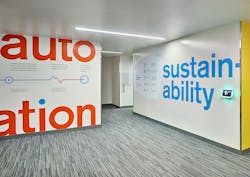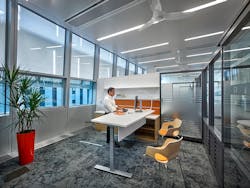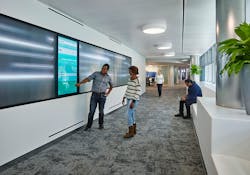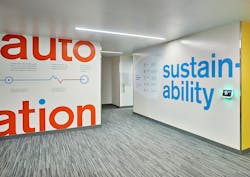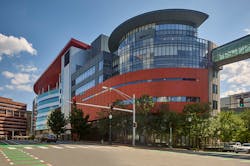Two years ago this fall, the landmark Unisphere building opened for its occupants — the management team and employees of United Therapeutics Corp. The elliptical, net-zero facility in downtown Silver Spring, MD, brings to life the sustainable mission of the biotechnology company and its pioneering founder, Martine Rothblatt, as detailed in the HPAC Engineering cover story of June 2019.
This year, the 210,000-sq.-ft. building completed its one-year validation period in April. In July, the project’s engineers at EwingCole — an integrated architecture/engineering firm headquartered in Philadelphia that designed Unisphere — completed an analysis of the first year’s energy metrics, comparing real-world data to the building performance numbers modeled during its design and construction.
“The building’s ‘soft’ opening was in September and occupancy was phased in,” says Jason Fierko, P.E., principal and director of energy management at EwingCole. “Final construction and commissioning continued through March 2019, so we started the validation period in April to ensure systems were fully commissioned and the building was fully occupied, to get an accurate accounting of energy use.”
Unisphere uses 3,000 solar photovoltaic panels across the building, generating 1,175 megawatt-hours of energy and a hybrid geo-exchange system, consisting of 52 wells drilled to a 500-ft. depth and supplemented with a 75-ton closed-circuit evaporative cooler. The condenser water feeds five water-to-water heat pumps, generating chilled and heated water for the six-story building.
Excellent Report Card
“Total consumption was approximately 6 percent below our predicted values, resulting in an Energy Use Intensity of 23.9 kBtu/sq. ft./year versus a modeled EUI of 25.4,” says Fierko. “However, solar production also was below the anticipated rate by approximately 22 percent, resulting in a total generation of 915 MWh. Luckily, we had a considerable safety factor in our numbers, so the building was still able to meet the zero net energy goal with a smaller than expected net export of renewable energy to the grid.”
The engineering team believes the reduced generation was connected to some of the solar inverters being offline for extended periods during the validation period, he explains.
“The solar provider was engaged, and those issues have mostly been resolved, so we’ve seen generation numbers increase,” Fierko notes. “We believe that next year’s performance on the generation side will be much improved as a result.”
Regarding energy consumption during the validation period, the savings were attributed to two systems: geo-exchange and lighting.
“The geo-exchange system performed better than expected, and this is a large user of energy,” Fierko adds. “Looking at the system in July, which was several days into a major heatwave, water temperature out of the well field was around 75° F. We haven’t seen it go much higher than that throughout the summer. Our modeling predicted temperatures into the mid-80s during the summer.”
As a result, he says, the reduced condenser water temperature greatly improved the efficiency of the water-to-water heat pumps in the building.
Fierko’s team had already reduced the lighting wattage density during the design phase but trimmed lighting levels by another 10 percent on average before occupancy.
“We completed a walk-through with light meters to fine-tune the lighting to design levels,” he explains. “We think the extensive use of vacancy and daylight sensing throughout the building increased the de-energized hours during the daytime beyond what we anticipated.”
The COVID-19 Factor
Everyone’s best-laid plans, of course, hit a monemumental snag this year with the unexpected and unwelcome arrival of the global pandemic and its overwhelming economic impact in Maryland and across the U.S. So, how did COVID-19 and related stay-at-home orders factor into Unisphere’s performance numbers?
Fierko says the building remained operational with some essential employees on site throughout.
“It was a good study to see how occupant-dependent the performance was,” he explains. “We do have information to compare May 2019 to May 2020. As expected, we saw occupant-dependent loads drop, but the other systems were somewhat consistent.”
Specifically, heavily occupant-dependent measures included:
- General equipment use, which saw a drop of around 20 percent; and
- Elevator use, not surprisingly, which fell by 60 percent.
“Overall building energy use, I would say, was minimally affected by the coronavirus shutdown,” Fierko says. “This illustrates, once again, that systems that are fully optimized are not heavily affected by changes to other parameters, whether those parameters be exterior climate, interior temperature adjustments or even building occupancy.”
Conservation and Comfort
A crucial element of Unisphere’s energy conservation plan is its building automation system (BAS), which has performed very well to date in coordinating the various heating, cooling and electrical systems.
“It gave us all the information we needed right at our fingertips,” Fierko says. “We always knew the building automation system was going to be a key element to the building’s success. We believe the combination of a robust control system, pre-construction mock-up and tireless commissioning effort provided the positive results.”
The integration among systems — lighting control, power metering, electrochromic glazing of the windows — all worked “seamlessly,” he adds. “I also think that the custom control interface in each office was a big hit with the occupants.”
United Therapeutics was keen to develop not only a sustainable building, but one where employees were comfortable and more productive. The custom control interface allows employees to control lighting at task level and overhead level, as well as ventilation, by opening and closing windows in the natural ventilation mode. Ceiling fans also allow people to control the speed to increase or decrease air movement.
Fierko adds that some adjustments were required shortly after occupancy. “We found that our design temperature range of 67° F in heating and 76° F in cooling was too extreme for the occupants, so it was adjusted by 2 degrees in each direction (69° F heating/74° F cooling). This had minimal impact on overall energy consumption since the baseline HVAC system was so efficient to start with.”
Due to Unisphere’s super-insulated envelope, the building holds on to its temperature very well, the team found, resulting in many hours where it is neither heating nor cooling.
“It stays in a static state with mechanical ventilation since it is still too cold outside to naturally ventilate,” he explains. “Power metering has been very valuable in assessing performance and uncovering any unexpected usage patterns. The integration between the building automation and lighting control system worked very well (and) contributed to the additional energy savings.”
To date, feedback has been very positive from both occupants and the award-winning site’s many visitors.
“As I mentioned previously, some adjustments were made to the temperature set points shortly after occupancy; the systems were able to maintain those conditions and still perform efficiently,” Fierko says. “The use of static graphics, digital displays and user interfaces throughout the building help to tell the sustainability story, as well as assist occupants in better understanding their role in the building’s performance. We believe it has been one of the most successful strategies employed in the building.”
For Ewing Cole, Unisphere is a success story of which it is proud to be a part. The firm is now in the process of getting it LEED Zero-certified, as well.
“Also, we plan to embark on a retro-commissioning effort shortly to see if we can tighten up the energy performance even more for the coming years,” Fierko says. “We believe Unisphere’s performance data shows that these types of buildings — if designed, constructed and commissioned appropriately — can perform as expected and aren’t just theoretical studies.”
########
To see our original cover story on the Unisphere in June 2019, click here.
About the Author

Kelly L. Faloon
Contributing Writer/Editor
Faloon spent 3 1/2 years at Supply House Times before joining the Plumbing & Mechanical staff in 2001. Previously, she spent nearly 10 years at CCH/Wolters Kluwer, a publishing firm specializing in business and tax law, where she wore many hats — proofreader, writer/editor for a daily tax publication, and Internal Revenue Code editor.
A native of Michigan’s northern Lower Peninsula, Faloon is a journalism graduate of Michigan State University. You can reach her at [email protected].
